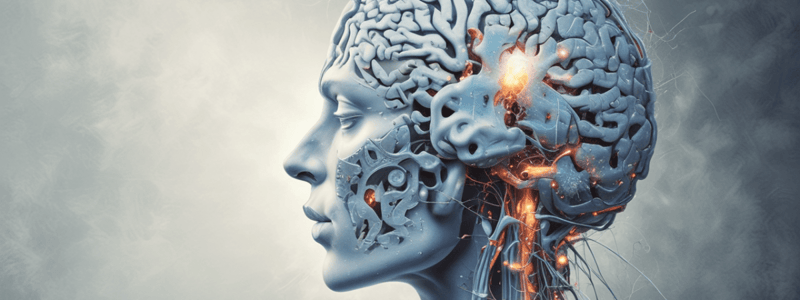Podcast
Questions and Answers
Traumatic Brain Injury (TBI), as defined by Centers for Disease Control & Prevention, is a traumatically-induced structural injury and/or physiological disruption of brain function resulting from an external force that is indicated by new onset or worsening of at least one of the following clinical signs immediately following the event:
Traumatic Brain Injury (TBI), as defined by Centers for Disease Control & Prevention, is a traumatically-induced structural injury and/or physiological disruption of brain function resulting from an external force that is indicated by new onset or worsening of at least one of the following clinical signs immediately following the event:
A leading cause of Alzheimer's Disease and Dementia is head injuries:
A leading cause of Alzheimer's Disease and Dementia is head injuries:
Diffuse Axonal Injury refers to:
Diffuse Axonal Injury refers to:
The Glasgow Coma Score classifies the severity of Traumatic Brain Injury in:
The Glasgow Coma Score classifies the severity of Traumatic Brain Injury in:
Select the study of choice for the initial assessment of TBI:
Select the study of choice for the initial assessment of TBI:
All of the following are positive imaging findings of Traumatic Brain Injury, EXCEPT:
All of the following are positive imaging findings of Traumatic Brain Injury, EXCEPT:
These are examples of therapeutic strategies in TBI cases:
These are examples of therapeutic strategies in TBI cases:
Having a negative CT scan rules out the diagnosis of Traumatic Brain Injury.
Having a negative CT scan rules out the diagnosis of Traumatic Brain Injury.
All of the following are examples of sources of evidence regarding behavioural changes in a TBI case:
All of the following are examples of sources of evidence regarding behavioural changes in a TBI case:
Common diagnoses involving in a TBI case include, EXCEPT:
Common diagnoses involving in a TBI case include, EXCEPT:
Flashcards are hidden until you start studying




